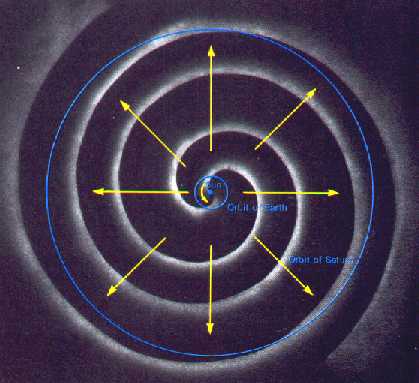Heliosphere
The atmosphere of the Sun (corona) is the place of the
departure of a plasma flow (electrically neutral mixture of ions and free
electrons) linked to magnetic fields, which is known as the
solar wind. Due to the Sunís rotation, this jet ends up assuming a spiral
archimedean shape, which extends until a distance of 7000 million km (beyond
the orbit of Pluto).

The solar magnetic field,
under the shape of an archimedean spiral (The New Solar System - 3rd edition)
Heliopause
The solar wind ends up merging with the interstellar environment and
losing its identity at a distance of 15 000 million km from the Sun, 100 times
higher than the one that separates the latter from the Earth (the heliopause).
Beyond the heliopause it may eventually be possible to detect interstellar
winds, proceeding from far more distant sources, holding different velocities,
compositions and directions.
Planetary Magnetic Fields
The magnetic fields of the planets are stretched by the solar wind,
producing magnetic tails that extend through millions of kilometres. Some
particles of the solar wind, captured by the planetary magnetic fields (of the inner and the outer
region), rain over the planetary atmospheres producing what we know as
"polar aurorae", resulting from the reactions with the gases that are
present at the upper atmospheres.

Polar aurora, in
Australia (Craig Richardson)
_